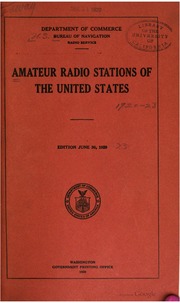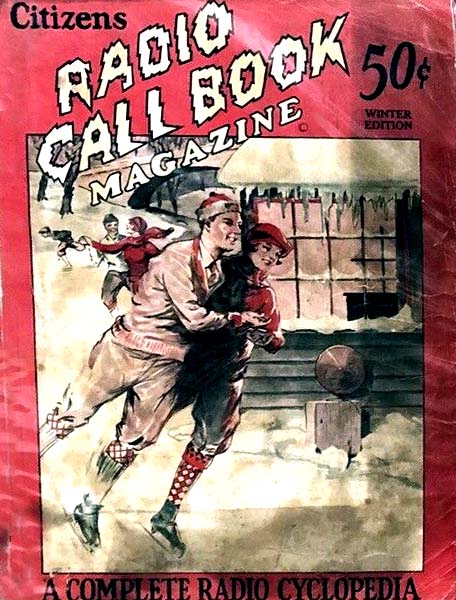The “Flying Horse” Radio Amateur Callbook, in hard copy telephone book format, had been providing listings of amateur radio callsigns since the early 1920s. However, modern technology led to its demise in 1997 then its resurrection in a CD-ROM format until 2002 when the plug was pulled on the CD-ROM. The first edition of the callbook appeared some time around 1920 or 1922 until it was discontinued in 1997 by the publisher Watson-Guptil of New York. Watson-Guptil, founded in 1937, eventually became a division of BPI Communications, New York. BPI’s Editorial and Customer Service offices were located in Lakewood, NJ. The hardcopy format of the callbook was the one that would serve the amateur radio community for most of its life. It is not known when Watson-Guptil took over publication after its founding in 1937, but it probably would have been some time afterwards.
The June, 1929, issue of QST advertises that the first Radio Amateur Call Book Magazine was produced by Radio Amateur Call Book Inc., of Chicago, Illinois. Both the U.S. and Canadian governments were each producing a call book that sold for 25 cents prepaid anywhere, so this new company was up against some heavy competition. Anything that the government normally produced would be so far out of date by the time it was available that this proved to be a blessing for the Radio Amateur Call Book Magazine. The Call Book Magazine became known the world over as “The Callbook”.
It was a bit challenging to find out the actual first year of
publication for the Flying Horse callbook. The web site (ITFM) selling
the 2019 version of the CD-ROM indicates that 2020 will be the 100th anniversary
of the callbook thus making the first year of publication in 1920. However,
a cover from the 1997 edition indicates that it’s a 75th
anniversary issue thus placing its first year of publication in 1922.
The 55th anniversary issue in 1977 also places the first edition date in
1922 so that must be the correct year. Perhaps the Flying Horse callbook
published under a different name from 1920 to 1922. That seems to
be the most logical explanation. ARRL HQ was not able to confirm the 1922
date.
 |
 |
|
| US Department of Commerce Amateur radio listings circa 1920. | Citzens Call book. The year was not printed on the cover. |
The Flying Horse callbook was not without competition. The US Department of Commerce published its own callbook from 1920 to 1931. Another source of listings was “The Citizens Radio Call Book” which published from 1921 to 1932. It listed both amateur (including Canada) and commercial US stations. This call book was published twice per year from 1920 to 1925. Then it ramped up to four issues a year until the publication was absorbed by Radio News. Another player in the game was the “Radio Directory and Publishing Company” of New York. Eventually, most of these callbooks fell by the wayside thus leaving the market open for domination by the Flying Horse callbook. Initially, the callbook was just one publication, however as the number of operators grew , it became necessary to split the callbook into a North American edition and a Foreign edition. The combined callbook likely continued well into the 1950s.
These hardcopy callbooks would persevere for many decades to come , however in 1997, Watson-Guptill phased out its long-familiar North American and International Callbooks on their 75th edition, citing "rising costs and increasing demand for electronic publishing”. One of the services offered to callbook subscribers was a free on-line update service. In order to use this service, the subscriber needed a computer attached to a 28.8 kbps modem and software which could emulate a DEC VT100A dumb terminal.
From 1997 to 2002, the callbook was offered in a CD-ROM format until rising costs and demand for on-line lookups put it out of business in the summer of 2002. That event was reported in an ARRL news release dated February 4, 2003. The callbook however, was not yet ready for burial. It was going to be resurrected but in a different form.
A German firm, ITFM--Informations-Technologie für Menschen (translated: Information Technology for People) purchased the rights to the Radio Amateur Callbook from Watson-Guptil , who had grounded the Flying Horse. The sale included rights to the Flying Horse logo and the Callbook archive. ITFM inked the deal on January 15, 2003. Two German radio amateurs, namely, Heinz Kamper DK4EI and Thomas Gudehus DB3 ZX were the principals who were key in arranging the deal. It took a while to clinch the sale due to some other competition, however the new CD-ROM by ITFM was made ready for the 2003 Dayton Hamvention.
Kamper and Gudehus said their Radio Amateur Callbook CD-ROM for summer 2003, would be a new and improved product, with an offering of twice-yearly revisions. They promised "the most complete and most accurate amateur radio callsign database. Besides data on more than 1.6 million amateurs, there would be information about DXCC entities, DX station QSL managers and even details on recent DXpeditions. The new product would work just as the previous one. Kamper and Gudehus had also left some 280 hard-copy editions (11 boxes in total) of the Radio Amateur Callbook, at ARRL Headquarters to replace worn and damaged copies in the ARRL's Callbook archive and also to fill some gaps..
By the time ITFM took over the Flying Horse callbook, they were well experienced with such a product as they produced CD-ROM listings for the Radio Society of Great Britain (RSGB) and for the Deutscher Amateur Radio Club (DARC) in Germany. They've also made available , a German logging program called ARMap that includes detailed map information.
Kamper, a ham since 1969, was general manager for 22 years of DARC Verlag, the DARC's publishing arm. Gudehus is an electrical engineer and programmer. He was licensed in 1986 at age 16. ITFM has contracted with InfoTech Internet Services (WC4H) in Miami, Florida, to be their distributor in the Americas The CD-ROM callbook is currently available from the ARRL web site as well as from ITFM .

